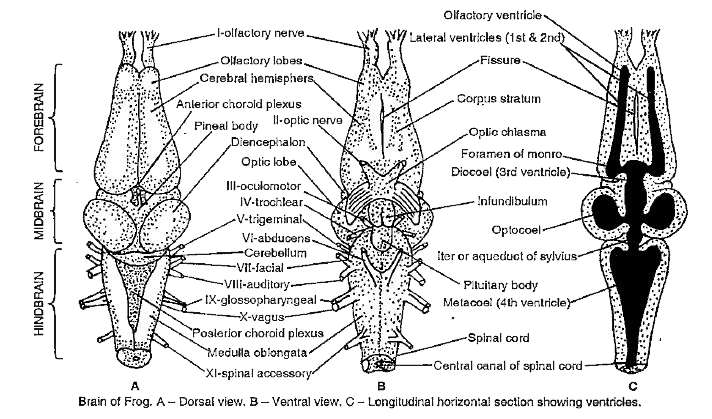Dicuss origin, location, meaning and structure of brain of a frog.
Text Solution
Brain :
Origin : Ectodermal
Location : Brain is a flattened structure lying inside the cranium of skull.
Meninges : It is surrounded by two connective tissue membranes called meninges (singular meninx)
1. Piamater: It is inner delicate pigmented, vascular and closely applied to brain.
2. Duramater : It is tough fibrous and lines the cranial cavity. The narrow space between the membranes·and the inner cavities of brain are filled with a clear watery and lymphatic cerebra-spinal fluid which protects and nourishes brain. The inner cavities of brain are called ventricles. Brain has three parts as fore brain , midbrain and hind brain.
1. Forebrain: It has (a) olfactory lobes (b) Cerebral hemispheres (c) diencephalon. (a) Olfactory lobes : These are two anteriormost, rather small and spherical lobes each sending a small olfactory nerve to the nasal chamber of its side. Each lobe has small cavity the olfactory ventricle or rhinocoel.
Function : Olfactory lobes are concerned with sense of smell.
(b) Cerebral hemispheres : Two large cerebral hemispheres collectively forms the cerebrum. These are long, oval and smooth structures, narrow in front but broad behind and separated from one another by a deep mid longitudinal fissure.
They have large cavities called I, II lateral ventricles or paracoels. These are continuous anteriorly with the olfactory ventricles. Posteriorly they unite. with each other and with the III ventricle or diacoel of diencephalon through foramen of monro. Thin roof of paracoel is called pallium but each ventro lateral side is thick, called corpus striatum, which is made of white medullated nerve fibre and cells. The two corpora striata (pleural) are joined together by a transverse fibrous tract the anterior comrnissure. Functions : The hemispheres are the seat of memory, intelligence, consciousness, will and regulate voluntary movements.
(c) Diencephalon: It is the short depressed region. Its small cavity III ventricle or diacoel has thick lateral walls called optic thalami (singular thalamus) and a thick floor called hypothalamus. Its dorsal roof contains a network of blood capillaries called anterior choroid plexus, behind which arises a small projection the pineal stalk that runs to the brown spot. In tadpole a small spherical pineal body is attached to the stalk, But it is detached and comes to lie outside skull in adult frog. X-shaped optic nerves just posterior to optic chiasma is a large median bilobed projection the infundibulum which bears pituitary body or hypophysis.
Function : Diencephalon is concerned with vision and balance.

Midbrain : It is the broadest part of brain having iter or aqueduct of sylvius which connects III ventricle and JV ventricle. Midbrain bears dorsolaterally two large rounded optic lobes called corpora bigemina. Their canals, called optocoels, open into iter. Two thick bands of nerve fibres called crura cerebri, run longitudinally beneath optic lobes connecting diencephalon and medulla. The optic lobes are concerned with sight.
3. Hindbrain : The posterior part of brain includes cerebellum and medulla oblongata.
(a) Cerebellum : It is a poorly developed narrow transverse solid ridge behind the optic lobes. It controls equilibrium and muscular coordination.
(b) Medulla oblongata : It is the last small conical part which is continuous with spinal cord. Its triangular cavity called IV ventricle or metacoel. The thin and highly vascular dorsal roof of metacoel forms the posterior choroid plexus.
Function: Medulla controls important involuntary functions such as heart beat, metabolism respiration etc.
|
Similar Questions
Knowledge Check
'Brain storming means
ATo collect all kind of ideas on a topicBTo do some mental exerciseCTo make efforts to understand somethingDTo give some kind of stimulus to the brainThird ventricle of brain is located in
ADiecephalonBRhombencephalonCMesencephalonDCerebrumLocation of eyes in frog is
Abehind the external nostrils on each side of headBin front of external nostrils on each side of headCbehind the external nostril on one side of headDin front of external nostril on one side of head
Which endocrine gland is located inside the brain in frogs?
View SolutionWhich endocrine gland is associated with the brain in frogs?
View SolutionWhich endocrine gland is associated with the brain in frogs?
View SolutionBrain and spinal cord (location)
View SolutionCerebrum is located in which part of the brain
View Solution
